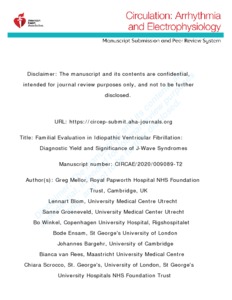Mellor, GJ;
Blom, LJ;
Groeneveld, SA;
Winkel, BG;
Ensam, B;
Bargehr, J;
van Rees, B;
Scrocco, C;
Krapels, IPC;
Volders, PGA;
et al.
Mellor, GJ; Blom, LJ; Groeneveld, SA; Winkel, BG; Ensam, B; Bargehr, J; van Rees, B; Scrocco, C; Krapels, IPC; Volders, PGA; Tfelt-Hansen, J; Krahn, AD; Hassink, RJ; Behr, ER
(2021)
Familial Evaluation in Idiopathic Ventricular Fibrillation: Diagnostic Yield and Significance of J-Wave Syndromes.
Circ Arrhythm Electrophysiol, 14 (3).
e009089.
ISSN 1941-3084
https://doi.org/10.1161/CIRCEP.120.009089
SGUL Authors: Scrocco, Chiara Behr, Elijah Raphael
![[img]](https://openaccess.sgul.ac.uk/112973/1.hassmallThumbnailVersion/Familial%20evaluation%20in%20IVF%20CircEP%202021%20AAM.pdf)  Preview |
|
PDF
Accepted Version
Available under License ["licenses_description_publisher" not defined].
Download (2MB)
| Preview
|
Abstract
Background:
Familial cascade screening is well established in patients with heritable cardiac disease and in cases of sudden arrhythmic death syndrome. The clinical benefit of family screening in idiopathic ventricular fibrillation (IVF) is unknown.
Methods:
Patients with IVF were identified from national and institutional registries. All underwent systematic and comprehensive clinical evaluation to exclude identifiable causes of cardiac arrest with a minimum requirement of ECG, cardiac (echocardiogram or magnetic resonance imaging) and coronary imaging, exercise ECG, and sodium channel blocker provocation. Additional investigations including genetic testing were performed at the physician’s discretion. First-degree relatives who were assessed with at least a 12-lead ECG were included in the final cohort. Results of additional investigations, performed at the physician’s discretion, were also recorded. Results were coded as normal, abnormal, or minor findings.
Results:
We identified 201 first-degree relatives of 96 IVF patients. In addition to a 12-lead ECG, echocardiography was performed in 159 (79%) and ≥1 additional investigation in 162 (80%) relatives. An inherited arrhythmia syndrome was diagnosed in 5 (3%) individuals from 4 (4%) families. Two relatives hosted the DPP6 risk haplotype identified in a single proband, one of whom received a primary prevention implantable cardioverter defibrillator. In 3 separate families, an asymptomatic parent of the IVF proband developed a type 1 Brugada ECG pattern during sodium channel blocker provocation. All were managed with lifestyle measures only. The early repolarization (ER) ECG pattern was present in 16% probands and was more common in relatives in those families than those where the proband did not have early repolarization (25% versus 8%, P=0.04).
Conclusions:
The yield of family screening in relatives of IVF probands is low when the proband is comprehensively investigated. The significance of J wave syndromes in relatives and the role for systematic sodium channel blocker provocation are, however, uncertain and require further research.
| Item Type: |
Article
|
| Additional Information: |
This is a non-final version of an article published in final form in Mellor, GJ; Blom, LJ; Groeneveld, SA; Winkel, BG; Ensam, B; Bargehr, J; van Rees, B; Scrocco, C; Krapels, IPC; Volders, PGA; et al. (2021) Familial Evaluation in Idiopathic Ventricular Fibrillation: Diagnostic Yield and Significance of J-Wave Syndromes. Circ Arrhythm Electrophysiol, 14 (3). e009089. |
| Keywords: |
J waves, early repolarization, family screening, idiopathic VF, J waves, early repolarization, family screening, idiopathic VF, Cardiovascular System & Hematology |
| SGUL Research Institute / Research Centre: |
Academic Structure > Molecular and Clinical Sciences Research Institute (MCS) |
| Journal or Publication Title: |
Circ Arrhythm Electrophysiol |
| ISSN: |
1941-3084 |
| Language: |
eng |
| Dates: |
| Date | Event |
|---|
| March 2021 | Published | | 7 February 2021 | Published Online | | 2 February 2021 | Accepted |
|
| Publisher License: |
Publisher's own licence |
| PubMed ID: |
33550818 |
 |
Go to PubMed abstract |
| URI: |
https://openaccess.sgul.ac.uk/id/eprint/112973 |
| Publisher's version: |
https://doi.org/10.1161/CIRCEP.120.009089 |
Statistics
Item downloaded times since 22 Feb 2021.
Actions (login required)
 |
Edit Item |



